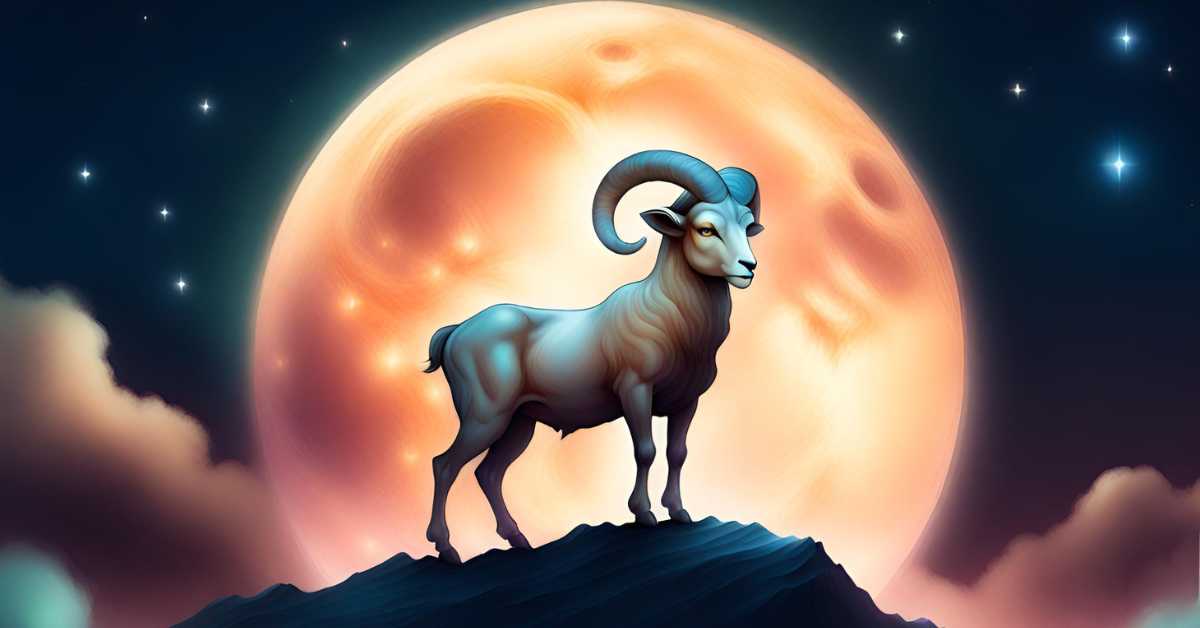ABOUT THE ARIES CONSTELLATION
The Aries constellation is located in the northern celestial hemisphere situated between the Pisces and Taurus zodiac constellations. The name Aries originates from the Latin word for the Ram. This star formation is among the 88 modern constellations, and one of 48 identified by the 2nd Century astronomer, Ptolemy.
It is a mid-sized constellation, ranked 39th largest, with an area of 441 square degrees. It occupies the first quadrant of the northern hemisphere (NQ1) and can be seen at latitudes between +90° and -60°. The neighboring constellations are Cetus, Perseus, Pisces, Taurus, and Triangulum. The brightest stars in the Aries constellation are Alpha Arietis, Beta Arietis, and Gamma Arietis. The brightest star is Alpha Arietis, an orange giant (66 light-years from Earth), also called Hamal, which is the Arabic word for “lamb” or “head of the ram.”
Aries was not officially recognized as a constellation until classical times. In Hellenistic astrology, the constellation of Aries is associated with the golden-fleeced ram of Greek mythology that rescued Phrixus and Helle. In a later myth, this Golden Fleece was stolen by Jason and the Argonauts.
Even before the Golden Fleece of Hellenistic mythos, earlier civilizations have also associated the Aries star formation with a ram. Babylon, Egypt, Persia, Greece, and Rome, all of them considered Aries to be a ram. Before that, the stars of Aries formed a farmhand. Different cultures have incorporated the stars of Aries into different constellations including twin inspectors in China and a porpoise in the Marshall Islands.
Babylonians identified Aries as the agrarian worker, the last stop on the ecliptic. The name of the constellation later changed to Ram, but why Babylonians changed it is uncertain. In the 7th century BC, Neo-Babylonians did a revision of the Babylonian zodiac that placed Alpha Arietis, Hamal, very close to the vernal equinox, which is how Aries came to be so prominent among the zodiac signs in astrology.
In those times, Aries contained the equinox, the point at which the Sun crosses the celestial equator from north to south. Because of precession (slow wobble of Earth’s axis), the vernal equinox is no longer in Aries, but in Pisces. In 130 BC, however, it was located just south of Gamma Arietis (Mesarthim) and was taken to be the starting point of the zodiac.

ARIES CONSTELLATION FACTS
- Abbreviation: Ari
- Symbolism: the Ram
- Right ascension: 01h 46m 37.3761s–03h 29m 42.4003s
- Declination: 31.2213154°–10.3632069°
- Area: 441[3] sq. deg. (39th)
- Stars with planets: 6
- Brightest star: Hamal (2.01m)
- Visible at latitudes between +90° and −60°.
- Best visible at 21:00 (9 p.m.) during the month of December.
ARIES CONSTELLATION MYTH & HISTORY
In Greek myth, Aries is identified with the golden ram that rescued Phrixus and took him to Colchis, where he sacrificed the ram to the gods. The ram’s skin that he placed in a temple was the Golden Fleece, which later appears in the story of Jason and the Argonauts.
Phrixus was the son of a Boeotian king. He had a twin sister, Helle. The children had a stepmother, Ino, who hated them and wanted to get rid of them. She came up with a plan to put the land of the brink of famine by making sure the wheat crops failed. When a man was sent to consult the Oracle at Delphi, Ino bribed him to lie and say the Oracle asked for the king’s children to be sacrificed if they did not want the people to starve.
JASON AND THE ARGONAUTS
In Greece, Aries was most associated with Jason and the Argonauts, in the story of the quest for the Golden Fleece. Jason was a victim of prophecy. Jason’s father was killed by his brother Pelias. Jason was spirited away to protect him, but an oracle warned Pelias that the boy would return. Jason was raised by the centaur Chiron (who is represented by the constellation Sagittarius). When Jason challenged Pelias, the pretender told Jason he would give him the throne in return for the Golden Fleece. Jason built a ship called the Argo, and crewed it with the Argonauts, some of the greatest heroes of Greece. Even Hercules sailed on the Argo. And with their help, he was finally successful.
In ancient Egyptian astronomy, Aries was associated with the god Amon-Ra, who was depicted as a man with a ram’s head and represented fertility and creativity. Because it was the location of the vernal equinox, it was called the “Indicator of the Reborn Sun”. During the times of the year when Aries was prominent, priests would process statues of Amon-Ra to temples, a practice that was modified by Persian astronomers centuries later. Aries acquired the title of “Lord of the Head” in Egypt, referring to its symbolic and mythological importance.
MIDDLE EAST
Medieval Muslim astronomers depicted Aries in various ways. Astronomers like al-Sufi saw the constellation as a ram, modeled on the precedent of Ptolemy. However, some Islamic celestial globes depicted Aries as a nondescript four-legged animal with what may be antlers instead of horns. Some early Bedouin observers saw a ram elsewhere in the sky; this constellation featured the Pleiades as the ram’s tail. The generally accepted Arabic formation of Aries consisted of thirteen stars in a figure along with five “unformed” stars, four of which were over the animal’s hindquarters and one of which was the disputed star over Aries’s head.
MAJOR STARS IN ARIES CONSTELLATION
HAMAL – ALPHA ARIETIS
Hamal, alternatively known as Alpha Arietis, is the brightest star in the northern zodiacal constellation of Aries. With an apparent visual magnitude of 2.0, it is among the brightest stars in the night sky. Hamal is about 65.8 light-years (20.2 parsecs) from Earth. It is a giant star that may host an orbiting planet with a mass greater than Jupiter.
SHERATAN – BETA ARIETIS
β Arietis, also known as Sheratan, is a blue-white star with an apparent visual magnitude of 2.64. Its traditional name is derived from “sharatayn”, the Arabic word for “the two signs”, referring to both Beta and Gamma Arietis in their position as heralds of the vernal equinox. The two stars were known to the Bedouin as “qarna al-hamal”, “horns of the ram”. It is 59 light-years from Earth. It has a luminosity of 11 L☉ and its absolute magnitude is 2.1.
MESARTHIM – GAMMA ARIETIS
γ Arietis, with a common name of Mesarthim, is a binary star with two white-hued components, located in a rich field of magnitude 8–12 stars. Its traditional name has conflicting derivations. It may be derived from a corruption of “al-sharatan”, the Arabic word meaning “pair” or a word for “fat ram”. However, it may also come from the Sanskrit for “first star of Aries” or the Hebrew for “ministerial servants”, both of which are unusual languages of origin for star names.
BHARANI – 41 ARIETIS
41 Arietis (abbreviated 41 Ari) is a triple star system in the northern constellation of Aries. With an apparent visual magnitude of 3.63, this system is readily visible to the naked eye. It has an annual parallax shift of 19.69 mas, which indicates it is at a distance of 166 light-years (51 parsecs) from the Sun.
BOTEIN – DELTA ARIETIS
Delta Arietis, also known as Botein, is an orange K-type giant star approximately 168 light years from Earth. It has an apparent magnitude of 4.35 and a diameter 13 times longer than that of the Sun. The star’s name is derived from the Arabic word butain, which means “belly.”
AL BUṬAIN – EPSILON ARIETIS
Epsilon Arietis is the Bayer designation for a visual binary star system in the northern constellation of Aries. It has a combined apparent visual magnitude of 4.63 and can be seen with the naked eye, although the two components are too close together to be resolved without a telescope. With an annual parallax shift of 9.81 mas, the distance to this system can be estimated as 330 light-years (100 parsecs), give or take a 30 light-year margin of error.
SEE MORE ZODIAC CONSTELLATIONS:
related posts:
Aries Daily Horoscope
Zodiac Elements
Zodiac Quadruplicities
The 12 Houses in Astrology
Want to know your astrology placements? You can generate your astrology chart here with our free birth chart generator tool.
- American Presidents Ranked By Zodiac Sign - January 20, 2025
- ESTP and ESFP in love: 6 Dynamics of Their Relationship - September 4, 2024
- ISFP and ISTP in love: 5 Dynamics of their Relationship. - August 28, 2024







i think this is not so famous. I heard this constellation , first time.